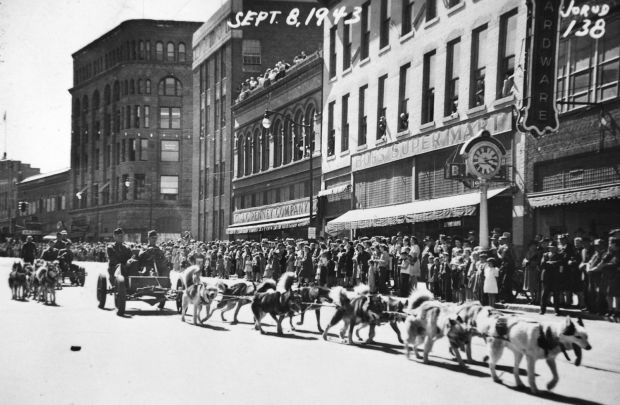Camp Rimini War Dog Reception and Training Center was established west of Helena. Dogs and soldiers were trained at the camp as a part of the effort to disrupt the Axis power. Going on to acquit itself in places along military air routes as search and rescue, it provided specialized transport in remote areas of the Northern Hemisphere such as Newfoundland. In Europe during winter operations the team provided transport of war material to our American forces. The Army Air Force organized and trained bomber forces throughout Montana at such locations as Great Falls, Lewistown, and Cutbank. The 7th Ferrying Command, Air Transport Command was formed at Great Falls (Gore Hill) and at East Base (now Malmstrom AFB), Montana to carry out the mission of providing aircraft and critical supplies to our allies over the Great Circle Route, a critical part of Global War Air Operations. Fort Missoula became an alien detention camp housing Italian sailors who had been caught up in the War 1942-43 with the result being a well disciplined and trustworthy population some of who went on to emigrate to the United States. Specialized units such the African-American, segregated, 555th Parachute Battalion, known as the Triple Nickels, trained and fought forest fires throughout Montana and the Northwest. The people of Montana supported the war effort in many ways on the Home Front, providing food, and other strategic supplies and minerals, meeting or exceeding the quotas for the eight War Bond Drives. Montanans support, fought, died and or wounded in all theaters of World War II, as Joseph Howard Kinsey wrote, In his book “High, Wide, and Handsome” of the more than 15 million men and women served in the U.S. Armed forces during the War period, Kinsey wrote, “– in World War II, Montana furnished 75,000 men and women to the effort. “Proportionately this was near the top of all states. In World War II, as in World War I, Montanans were quick to enlist and they were healthy; the proportion rejected because of physical defect was smaller than the national average. Montana’s death rate in World War II was only exceeded by that of New Mexico in proportion to population. Montana had the record of oversubscribing first in eight World War II saving bond drives.” Today less than 2,000 World War II count Montana as their home.


